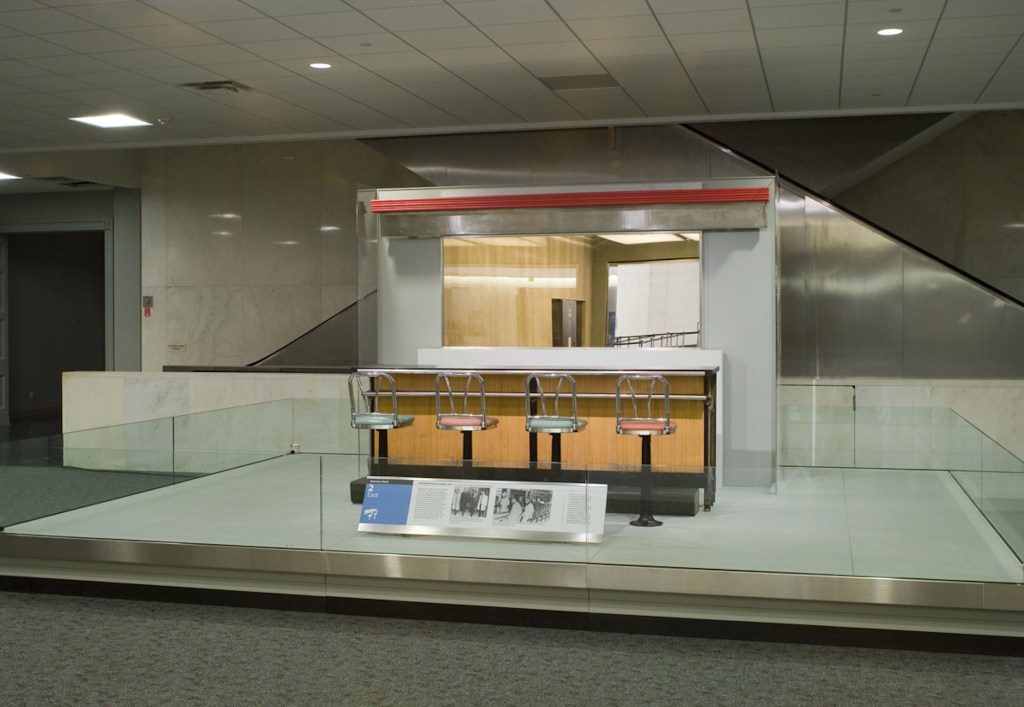Smithsonian Institution Says It Won’t Remove Anti-Segregation Exhibits


The Smithsonian Institution denied reports this morning, April 28, that its National Museum of American History (NMAH) and the National Museum of African American History and Culture (NMAAHC) intended to remove object displays documenting anti-segregation demonstrations during the Civil Rights Movement.
Following President Trump’s executive order last month calling for the elimination of “race-centered ideology” in the Smithsonian, Black Press USA reported on April 24 that the institution planned to remove items related to a segregated F.W. Woolworth Company lunch counter from Greensboro, North Carolina, the site of historic anti-segregation sit-ins. In February 1960, four Black college students sat at the counter, igniting a wave of similar demonstrations in 126 cities. The NMAACH displays a stool from the historic lunch site in its “Segregation Gallery,” and the NMAH maintains an indefinite exhibition on the demonstrations, which features part of the physical lunch counter.
In a statement, NMAAHC spokesperson Melissa Wood told Hyperallergic that claims that the museums are purging certain artifacts are “false.” The statement Wood shared with Hyperallergic was published this morning on the Smithsonian’s website.
“Both the Greensboro lunch counter and stools where college students sat in protest during the Civil Rights Movement are and continue to be on display,” Wood said.
In an update, Black Press USA said its original report was based on sources “close to the issue.”
The publication was also the first to report that the NMAAHC would return loaned artifacts, which had been on view since the museum’s 2016 opening, to San Francisco Third Baptist Church Reverend and civil rights leader Amos Brown. The reverend said he received an email on April 10 notifying him that two books he had loaned to the museum — his father’s Bible, which he used during demonstrations, and George W. Williams’s History of the Negro Race in America 1618–1880 (1883) — would be sent back to him. In interviews, Brown described Williams’s history as one of the first to document racism in America.
In an email, an NMAACH registrant told Brown the items were being returned “in order to preserve them and not display them for too long.”
But Brown told WUSA9 the preservation explanation was a “flimsy excuse.”
“I had called them and told them how unfortunate and ideological it is,” he told WUSA9, suggesting that the return of his items could be related to Trump’s mandates targeting critical race theory.
The Smithsonian denies that any objects have been removed “for reasons other than adherence to standard loan agreements or museum practices.” The institution frequently returns artifacts based on agreements with lenders, preservation efforts, and as part of “regular museum turnover,” according to the Smithsonian’s statement.
Amos Brown has not yet responded to Hyperallergic’s request for comment.
Though the Greensboro lunch counter display appears safe for the time being, the same cannot be said for other aspects of Smithsonian programming that the Trump administration has increasingly threatened to dismantle, such as projects that embrace inclusive views of gender.
Trump’s March executive order targeting the Smithsonian specifically criticized the NMAAHC for including a graphic on its website in 2020 that examined “assumptions of Whiteness in the United States.” The graphic described aspects of “white dominant culture,” including the nuclear family structure and blondeness and thinness as beauty standards. (The museum removed the graphic that year following conservative backlash and issued an apology.)
The architect of the executive action facilitating the Trump administration crackdown appears to be Lindsey Halligan, a lawyer with the mouthful of a title “Assistant to the President for Domestic Policy and the Special Assistant to the President and Senior Associate Staff Secretary.”
Halligan told the Washington Post this week that it was her idea to introduce executive orders to address “improper ideology” in the national institution, including exhibitions of “art and sculpture that describe on the placards next to it that America and sculpture are inherently racist,” apparently referencing the ongoing show The Shape of Power: Stories of Race and American Sculpture on view at the NMAH. That exhibition was cited in Trump’s executive order for the Smithsonian, which also included language echoing the pseudoscientific belief of race as a “biological reality.”
In the weeks since Trump named NAAMHC in his executive order, Black churches have stepped up to support the museum, encouraging parishioners to purchase a $25 annual membership.





